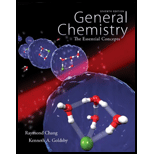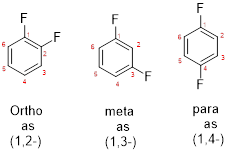
Connect 2-Year Access Card for Chemistry: The Essential Concepts
7th Edition
ISBN: 9780077623302
Author: Kenneth Goldsby Professor, Raymond Chang Dr.
Publisher: McGraw-Hill Education
expand_more
expand_more
format_list_bulleted
Concept explainers
Question
Chapter 11, Problem 11.32QP
(a)
Interpretation Introduction
Interpretation:
The given compound has to be named.
Concept Introduction:
- The parent compound of aromatic compound is Benzene.
- A substituent group contains group of atoms attached to the carbon atom of the aromatic ring.
- While numbering the parent, the location of the second group relative to the first substituent uses prefixes like o-ortho (1,2-), m-meta (1,3-), and p-para (1,4) in disubstituted aromatic ring.

(b)
Interpretation Introduction
Interpretation:
The given compound has to be named.
Concept Introduction:
IUPAC Nomenclature of Aromatic compounds:
- The parent compound of aromatic compound is Benzene.
- A substituent group contains group of atoms attached to the carbon atom of the aromatic ring.
- While numbering the parent, the location of the second group relative to the first substituent uses prefixes like o-ortho (1,2-), m-meta (1,3-), and p-para (1,4) in disubstituted aromatic ring.

c)
Interpretation Introduction
Interpretation:
The given compound has to be named.
Concept Introduction:
IUPAC Nomenclature of Aromatic compounds:
- The parent compound of aromatic compound is Benzene.
- The substituent groups attached to the parent is identified. A substituent group contains group of atoms attached to the carbon atom of the aromatic ring.
- While numbering the parent, the location of the second group relative to the first substituent uses prefixes like o-ortho (1,2-), m-meta (1,3-), and p-para (1,4) in disubstituted aromatic ring.

Expert Solution & Answer
Want to see the full answer?
Check out a sample textbook solution
Chapter 11 Solutions
Connect 2-Year Access Card for Chemistry: The Essential Concepts
Ch. 11.2 - Prob. 1PECh. 11.2 - Prob. 2PECh. 11.2 - Prob. 3PECh. 11.2 - Prob. 1RCCh. 11.3 - Prob. 1RCCh. 11.4 - Prob. 1PECh. 11.4 - Prob. 1RCCh. 11.5 - Prob. 1PECh. 11.5 - Prob. 1RCCh. 11 - Prob. 11.1QP
Ch. 11 - Prob. 11.2QPCh. 11 - Prob. 11.3QPCh. 11 - 11.4 What are structural isomers?
Ch. 11 - Prob. 11.5QPCh. 11 - 11.6 Draw skeletal structures of the boat and...Ch. 11 - 11.7 Alkenes exhibit geometric isomerism because...Ch. 11 - 11.8 Why is it that alkanes and alkynes, unlike...Ch. 11 - Prob. 11.9QPCh. 11 - 11.10 Describe reactions that are characteristic...Ch. 11 - Prob. 11.11QPCh. 11 - Prob. 11.12QPCh. 11 - Prob. 11.13QPCh. 11 - Prob. 11.14QPCh. 11 - Prob. 11.15QPCh. 11 - Prob. 11.16QPCh. 11 - Prob. 11.17QPCh. 11 - 11.18 Draw Newman projections of four different...Ch. 11 - 11.19 Draw the structures of cis-2-butene and...Ch. 11 - 11.20 Would you expect cyclobutadiene to be a...Ch. 11 - Prob. 11.21QPCh. 11 - Prob. 11.22QPCh. 11 - 11.23 Sulfuric acid (H2SO4) adds to the double...Ch. 11 - Prob. 11.24QPCh. 11 - Prob. 11.25QPCh. 11 - Prob. 11.26QPCh. 11 - Prob. 11.27QPCh. 11 - Prob. 11.28QPCh. 11 - Prob. 11.29QPCh. 11 - 11.30 Benzene and cyclohexane both contain...Ch. 11 - Prob. 11.31QPCh. 11 - Prob. 11.32QPCh. 11 - Prob. 11.33QPCh. 11 - Prob. 11.34QPCh. 11 - Prob. 11.35QPCh. 11 - Prob. 11.36QPCh. 11 - Prob. 11.37QPCh. 11 - Prob. 11.38QPCh. 11 - Prob. 11.39QPCh. 11 - Prob. 11.40QPCh. 11 - Prob. 11.41QPCh. 11 - Prob. 11.42QPCh. 11 - Prob. 11.43QPCh. 11 - Prob. 11.44QPCh. 11 - Prob. 11.45QPCh. 11 - Prob. 11.46QPCh. 11 - Prob. 11.47QPCh. 11 - Prob. 11.48QPCh. 11 - Prob. 11.49QPCh. 11 - Prob. 11.50QPCh. 11 - Prob. 11.51QPCh. 11 - Prob. 11.52QPCh. 11 - Prob. 11.53QPCh. 11 - Prob. 11.54QPCh. 11 - Prob. 11.55QPCh. 11 - Prob. 11.56QPCh. 11 - Prob. 11.57QPCh. 11 - Prob. 11.58QPCh. 11 - Prob. 11.59QPCh. 11 - Prob. 11.60QPCh. 11 - Prob. 11.61QPCh. 11 - Prob. 11.62QPCh. 11 - Prob. 11.63QPCh. 11 - Prob. 11.64QPCh. 11 - Prob. 11.65QPCh. 11 - Prob. 11.66QPCh. 11 - Prob. 11.67QPCh. 11 - Prob. 11.68QPCh. 11 - Prob. 11.69QPCh. 11 - Prob. 11.70QPCh. 11 - Prob. 11.71QPCh. 11 - Prob. 11.72QPCh. 11 - 11.73 Octane number is assigned to gasoline to...Ch. 11 - Prob. 11.74SPCh. 11 - Prob. 11.75SPCh. 11 - Prob. 11.76SPCh. 11 - Prob. 11.77SPCh. 11 - Prob. 11.78SP
Knowledge Booster
Learn more about
Need a deep-dive on the concept behind this application? Look no further. Learn more about this topic, chemistry and related others by exploring similar questions and additional content below.Recommended textbooks for you
 ChemistryChemistryISBN:9781305957404Author:Steven S. Zumdahl, Susan A. Zumdahl, Donald J. DeCostePublisher:Cengage Learning
ChemistryChemistryISBN:9781305957404Author:Steven S. Zumdahl, Susan A. Zumdahl, Donald J. DeCostePublisher:Cengage Learning ChemistryChemistryISBN:9781259911156Author:Raymond Chang Dr., Jason Overby ProfessorPublisher:McGraw-Hill Education
ChemistryChemistryISBN:9781259911156Author:Raymond Chang Dr., Jason Overby ProfessorPublisher:McGraw-Hill Education Principles of Instrumental AnalysisChemistryISBN:9781305577213Author:Douglas A. Skoog, F. James Holler, Stanley R. CrouchPublisher:Cengage Learning
Principles of Instrumental AnalysisChemistryISBN:9781305577213Author:Douglas A. Skoog, F. James Holler, Stanley R. CrouchPublisher:Cengage Learning Organic ChemistryChemistryISBN:9780078021558Author:Janice Gorzynski Smith Dr.Publisher:McGraw-Hill Education
Organic ChemistryChemistryISBN:9780078021558Author:Janice Gorzynski Smith Dr.Publisher:McGraw-Hill Education Chemistry: Principles and ReactionsChemistryISBN:9781305079373Author:William L. Masterton, Cecile N. HurleyPublisher:Cengage Learning
Chemistry: Principles and ReactionsChemistryISBN:9781305079373Author:William L. Masterton, Cecile N. HurleyPublisher:Cengage Learning Elementary Principles of Chemical Processes, Bind...ChemistryISBN:9781118431221Author:Richard M. Felder, Ronald W. Rousseau, Lisa G. BullardPublisher:WILEY
Elementary Principles of Chemical Processes, Bind...ChemistryISBN:9781118431221Author:Richard M. Felder, Ronald W. Rousseau, Lisa G. BullardPublisher:WILEY

Chemistry
Chemistry
ISBN:9781305957404
Author:Steven S. Zumdahl, Susan A. Zumdahl, Donald J. DeCoste
Publisher:Cengage Learning

Chemistry
Chemistry
ISBN:9781259911156
Author:Raymond Chang Dr., Jason Overby Professor
Publisher:McGraw-Hill Education

Principles of Instrumental Analysis
Chemistry
ISBN:9781305577213
Author:Douglas A. Skoog, F. James Holler, Stanley R. Crouch
Publisher:Cengage Learning

Organic Chemistry
Chemistry
ISBN:9780078021558
Author:Janice Gorzynski Smith Dr.
Publisher:McGraw-Hill Education

Chemistry: Principles and Reactions
Chemistry
ISBN:9781305079373
Author:William L. Masterton, Cecile N. Hurley
Publisher:Cengage Learning

Elementary Principles of Chemical Processes, Bind...
Chemistry
ISBN:9781118431221
Author:Richard M. Felder, Ronald W. Rousseau, Lisa G. Bullard
Publisher:WILEY